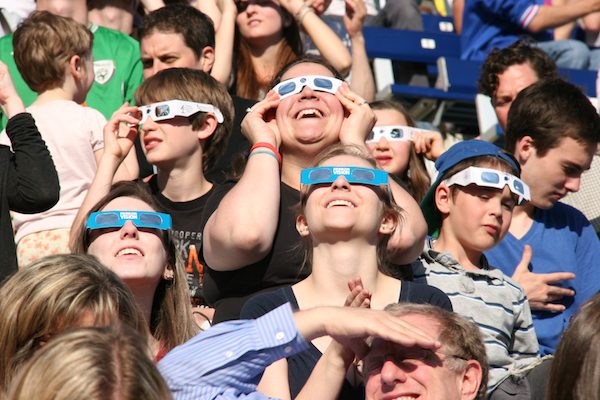
Astronomers lauded for helping others understand Solar System
Published: June 11, 2013
It was one of the largest astronomy outreach events ever – attracting more than 5000 spectators to the Varsity Stadium at the University of Toronto, eager to watch the transit of Venus.
Held one year ago, the massive gathering allowed members of the public to witness the transit through solar-viewing glasses, telescopes and live on the stadium Jumbotron.
Astronomers and graduate students from the Dunlap Institute, the Department of Astronomy & Astrophysics (DAA) and the Canadian Institute for Theoretical Astrophysics (CITA) were on hand to answer questions and the event also included free shows in the university’s portable planetarium, a public talk and a performance from the play “Transit of Venus.”
Now, U of T's Dunlap Institute for Astronomy & Astrophysics has won two CASE awards for its 2012 Transit of Venus event: a Silver Circle of Excellence Award in the category of Public Relations and Community Relations Projects and a Bronze for Individual Special Event.
The awards are a program of the Council for Advancement and Support of Education, or CASE, an international association that serves professionals in educational institutions who work in alumni relations, communications, development and marketing.
“The CASE awards are gratifying recognition of the Dunlap Institute’s commitment to engaging the public in appreciation of the wonders of the Universe and our place in it,” says Dunlap interim director, Professor Peter Martin. “We look forward to continuing to fulfill our mandate, through existing programs like our planetarium and initiatives like the transit event, and by staging many stimulating events and activities in the coming years.”
The Transit of Venus at Varsity Stadium was organized by the Dunlap Institute with the support of the Advancement Office of the Faculty of Arts & Science, and in partnership with the DAA, CITA, the Institute for the History and Philosophy of Science & Technology, the Royal Astronomical Society of Canada and the Fédération des Astronomes Amateurs du Québec.
“We were very happy that so many people came to to see the transit with their own eyes and had a chance to interact with our astronomers," said the Dunlap’s Public Outreach Coordinator Michael Reid, who led the large team that pulled off the event.
"We hope that everyone who enjoyed the event will stay tuned to the Dunlap Institute for more great events of this type. We’re already working hard on more surprises.”
The Dunlap Institute for Astronomy & Astrophysics continues the legacy of the David Dunlap Observatory of developing innovative astronomical instrumentation, including instrumentation for the largest telescopes in the world, said Reid. He added that the research of its faculty and Dunlap Fellows spans the depths of the Universe, from the discovery of exoplanets, to the formation of stars, the evolution and nature of galaxies, dark matter, the Cosmic Microwave Background and SETI. (Read more about the Dunlap Institute.)
The institute also continues a strong commitment to developing the next generation of astronomers and fostering public engagement in science, said Reid. (Read more about science engagement at U of T.)
Chris Sasaki is a writer with the Dunlap Institute for Astronomy & Astrophysics at the University of Toronto.



